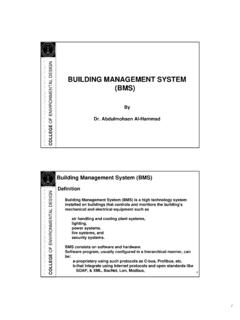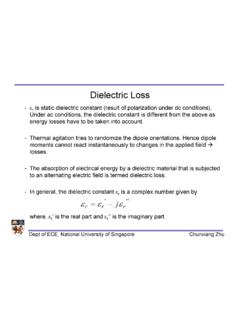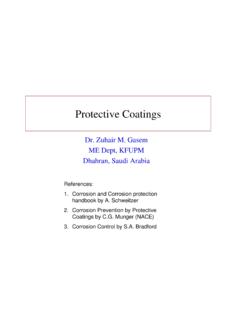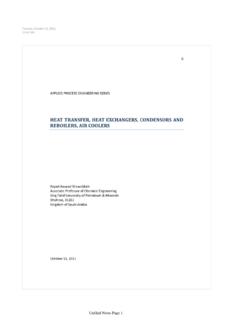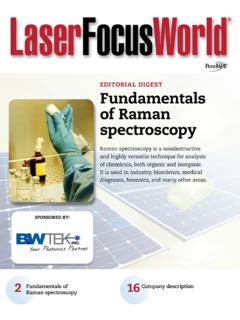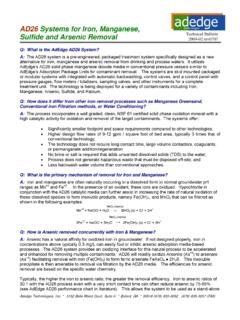Transcription of Iron and Mangenese Removal 062 - KFUPM
1 111CE 370CE 370 iron and manganese Removal22 iron and manganese Removal ; OverviewIron and manganese Removal ; Overview iron and manganese are natural constituents of soil and rocks. Usually natural waters have an iron content which is greater than manganese content. Waters are seldom found which have iron levels greater than 10 mg/l or manganese levels greater than 2 mg/l. iron exists in the +2 or +3 oxidation states, whereas manganese exists in either the +2, +3, +4, +6, or +7 oxidation states. However, iron (III) and manganese (IV) are the only stable oxidation states found in waters containing oxygen. 233 What problems are caused by iron and What problems are caused by iron and manganese ? manganese ?
2 The presence of significant amounts of either or both of theses metals in a water supply can create several problems for the consumers. The problems caused by the presence of iron including: Large concentration of iron impart a metallic taste to the water. Industrial products such as paper, textiles, or leather may be discolored. Household fixtures such as porcelain basins, bathtubs, glassware, and dishes are stained. Clothes may stain a yellow or brown-yellow color. iron precipitates clog pipes and promote the growth of gelatinous masses of iron bacteria. These bacteria slough off and create red water iron bacteria may cause odor and taste problems, particularly, when the flow in pipes is problems are caused by iron and What problems are caused by iron and manganese ?
3 manganese ?355 What problems are caused by iron and What problems are caused by iron and manganese ? manganese ?The problems caused by the presence of manganese are similar to those of iron : High concentrations of manganese may produce taste problems. manganese may cause a discoloration of industrial products similar to that caused by iron . Household fixtures may be stained a brown or black color. Clothes may be stained and become dingy or is the chemistry of iron and manganese What is the chemistry of iron and manganese in water systems?in water systems? iron (Fe) and manganese (Mn) can be present in water in one of three basic forms:1. Dissolved: ferrous (Fe2+) and manganous (Mn2+) states2. Particulate: ferric (Fe3+) and manganic (Mn4+) states3.
4 Colloidal: very small particles (difficult to settle and filter). The predominance of one form over another is dependent on the pH, Eh (redox potential), and temperature of the water. Knowledge of the forms or states of iron and manganese can help fine-tune a given treatment practice for these water standards for iron and Drinking water standards for iron and manganese ? manganese ? iron and manganese are common in groundwater supplies and their presence in drinking water do not pose health hazard. There are secondary standards set for iron and manganese , but these are not health related and are not enforceable. The secondary (aesthetic) MCLs for iron and manganese are milligrams per liter (mg/l) and mg/l, respectively Exceeding the suggested maximum contaminant levels (MCL) usually results in discolored water, laundry, and plumbing fixtures.
5 This, in turn, results in consumer complaints and a general dissatisfaction with the water utility. Any water containing iron and manganese above the recommended levels should be treated to reduce the levels below the are the most common treatment What are the most common treatment processes?processes? The majority of iron and manganese treatment systems employ the processes of oxidation/filtration. The oxidant chemically oxidizes the iron or manganese (forming a particle). The filter then removes the iron or manganese particles. Oxidation followed by filtration is a relatively simple process. 599 OxidationOxidation Before iron and manganese can be filtered, they need to be oxidized to a state in which they can form insoluble complexes.
6 Oxidation involves the transfer of electrons from the iron , manganese , or other chemicals being treated to the oxidizing agent. Ferrous iron (Fe2+) is oxidized to ferric iron (Fe3+), which readily forms the insoluble iron hydroxide complex Fe(OH)3. manganese (Mn2+) is oxidized to (Mn4+), which forms insoluble (MnO2).1010 OxidationOxidation The most common chemical oxidants in water treatment are chlorine, chlorine dioxide, potassium permanganate, ozone, and oxygen. Chlorinationis widely used for oxidation of divalent iron and manganese . However, the formation of trihalomethanes (THMs) in highly colored waters may be a problem. Following is the oxidation reaction of chlorine:61111 OxidationOxidation1212 OxidationOxidation Potassium permanganate (KMnO4)is normally more expensive than chlorine and ozone.
7 For iron and manganese Removal , it is as efficient and it requires considerably less equipment and capital investment. The dose of potassium permanganate, however, must be carefully controlled. Too little permanganate will not oxidize all the iron and manganese , and too much will allow permanganate to enter the distribution system and cause a pink color. Permanganate can also form precipitates that cause mudballformations on filters. These are difficult to remove and compromise filter of iron and manganese from groundwaterRemoval of iron and manganese from groundwater1414 OxidationOxidation Ozonemay be used for iron and manganese oxidation. Ozone may not be effective for oxidation in the presence of humic or fulvic materials.
8 If not dosed carefully, ozone can oxidize reduced manganese to permanganate and result in pink water formation as well. manganese dioxide particles, also formed by oxidation of reduced manganese , must be carefully coagulated to ensure their Removal . 81515 OxidationOxidation A low-cost method of providing oxidation is to use the oxygen in air as the oxidizing agent in a tray aerator. Water is simply passed down a series of porous trays to provide contact between air and water. Oxygen is not a strong enough oxidizing agent to break the strong complexes formed between iron and manganese and large organic molecules. Furthermore, the rate of reaction between oxygen and manganese is very slow below pH values of After oxidation of iron and manganese , the water is filtered to remove insoluble (particulate) ferric hydroxides and manganese oxides.
9 There are different filtration media for the Removal of iron andmanganese, including manganese greensand, anthra/sand, electromedia, and ceramic. manganese greensand is by far the most common medium in use for Removal of iron and manganese through pressure filtration. Greensand is a processed material consisting of grains of the zeolite mineral glauconite. The material is coated with manganese oxide. This coating is maintained through either continuous or intermittent feed of potassium permanganate. 91717 FiltrationFiltration Anthra/sand are other types of media available for Removal of iron and manganese . They consist of select anthracite and sand with a chemically bonded manganese oxide coating.
10 Unlike manganese greensand, these media are conditioned in the filter after media installation. Electromedia provides a slightly different option from the manganese oxide coated media. This is a proprietary multi-media formulation which uses a naturally occurring zeolite and does not require potassium permanganate regeneration. Finally, macrolite is a manufactured ceramic material with a spherical shape and a rough, textured surface. The principal Removal mechanism is physical straining rather than contact oxidation or ; mediaFiltration; mediaManganese greensandanthracite101919 Alternative TreatmentsAlternative Treatments Sequestration Sequestration is the addition of chemicals to groundwater aimed at controlling problems caused by iron and manganese without removing them.
